Introduction
In the beginning, before the Norse cosmos took form, there was only Ginnungagap—a vast, yawning void, suspended in timeless silence. Neither day nor night existed, nor earth or sky, only an endless chasm separating the realms of fire and ice. In Norse mythology, this primordial space held the potential for all creation, a place where opposing forces would converge and give rise to something extraordinary. Within this mythic gap, where the fires of Muspelheim met the icy streams of Niflheim, the first being, Ymir, came into existence—the primeval giant of Norse mythology.
Ymir, a giant of immeasurable size and ancient mystery, was no ordinary creature. He embodied the raw chaos of creation itself, a primal force whose very existence stirred the energies that would shape the universe. He was both creator and destroyer, a figure representing untamed nature, and it was from his body that the Norse gods would forge the world. Ymir’s story, one of birth, destruction, and transformation, holds a unique place in Norse cosmology as the origin of life, earth, and the heavens. Yet, like many giants in myth, his role was paradoxical, for his existence would ultimately lead to his own demise—a sacrifice that laid the foundations for life.
The tale of Ymir is more than a simple origin story; it is a complex narrative reflecting Norse views on life, death, and the cyclical nature of existence. Giants in Norse mythology, often seen as embodiments of chaos and raw elemental power, symbolise a time before order, a realm before the gods took control. Ymir stands as a testament to this untamed period, a figure of awe and fear, whose presence bridged the chaos of Ginnungagap with the structured realms of gods and mortals. From his vast body emerged the land, seas, and skies, a transformation both brutal and beautiful, marking the shift from formless void to a world teeming with life.
In exploring Ymir’s myth, we journey into the heart of Norse cosmology, a world where creation springs from conflict, where chaos gives way to order, and where giants walk the line between life and death. The story of this primeval giant is not merely a legend of the past; it is a reflection of humanity’s own desire to understand existence and the forces that shape our world. As we delve deeper into the mythology surrounding Ymir, we encounter a narrative both haunting and enchanting, revealing the timeless power of the Norse creation myth and its enduring influence on culture, art, and literature.
The Mythical Origins of Ymir, the Primeval Giant
In Norse mythology, the story of creation begins not with gods or men, but with Ymir, the primeval giant of Norse mythology who emerged from the silent abyss of Ginnungagap. This void, an expanse between the fiery land of Muspelheim and the frozen wastes of Niflheim, was a space where extreme forces collided. It was here, within this primordial chasm, that Ymir was formed—a being born of both fire and ice, embodying the chaotic potential of the universe itself.
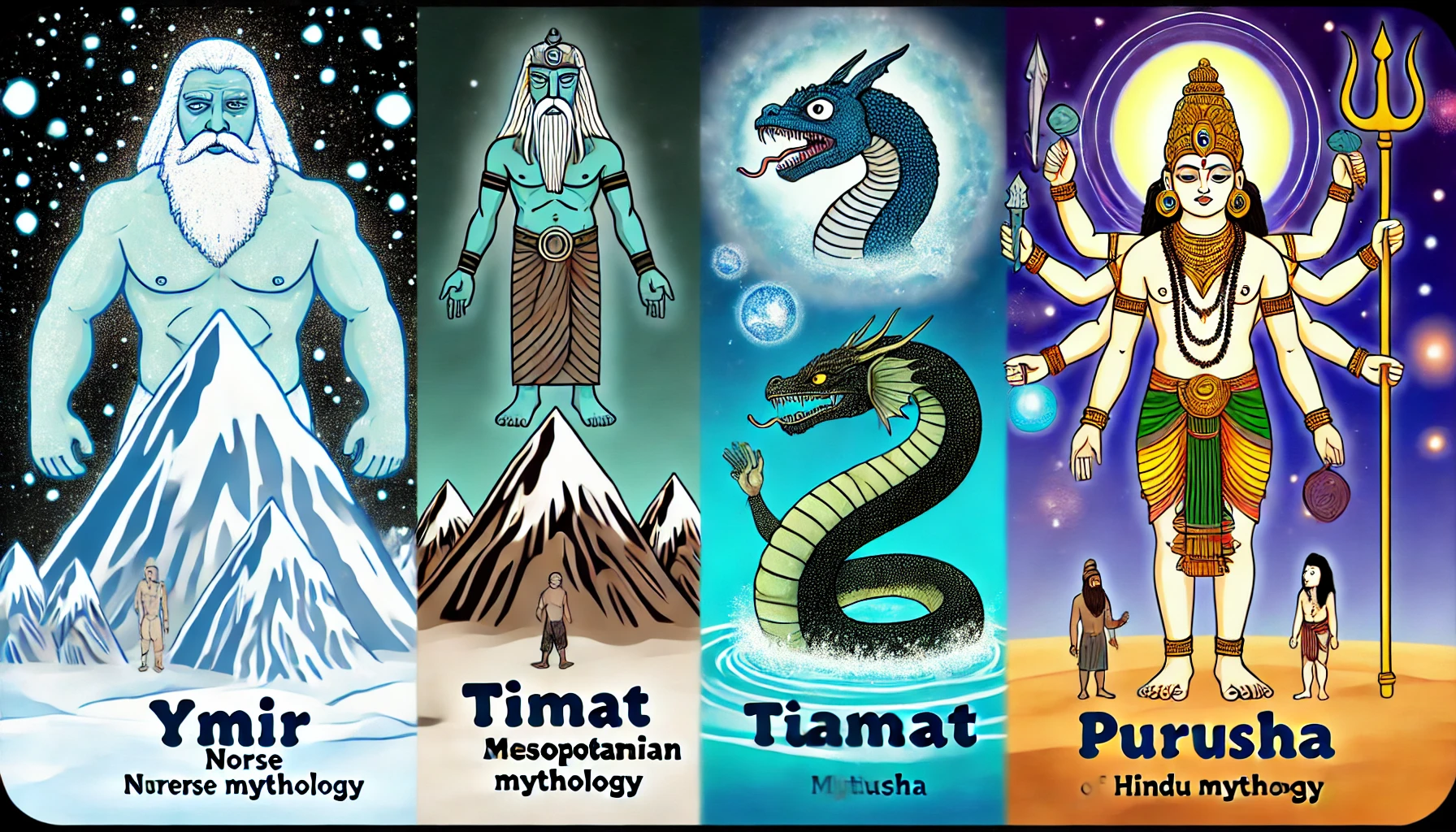
Ginnungagap: The Abyss Before Creation
Ginnungagap, often referred to as the “Yawning Void,” served as a blank canvas for creation, an untouched expanse where nothing yet existed. In this place, neither light nor darkness held sway, and the elements of fire and frost lay dormant on either side. The fiery land of Muspelheim, home to flames and smouldering heat, stood in contrast to the icy realm of Niflheim, where glaciers and freezing mists reigned. When the two realms finally met, sparks and frost mingled, releasing the vital forces that would give rise to life.
As warmth from Muspelheim began to thaw the frozen streams of Niflheim, droplets formed, and from these primal waters, Ymir took shape. His emergence was a fusion of opposites, an entity born of extremes, symbolising both the destructive and creative powers of the cosmos. In many ways, Ymir’s birth represents the first stirring of life from lifelessness, the raw potential of creation that lay dormant within Ginnungagap.
Birth of Ymir: Emergence from the Elements
Unlike mortals or even gods, Ymir was a self-sustaining force of nature, a primeval giant whose body defied the conventional laws of life and death. He was a being of great size and power, and his form contained the essence of both Muspelheim and Niflheim. According to Norse myth, as Ymir slept, his body gave rise to a new cycle of life. Sweating in his sleep, he produced the first giants, beings as vast and untamed as himself. This spontaneous generation reflects Ymir’s unique position in the Norse cosmos: a creature of endless potential, whose very existence propagated life.
One of Ymir’s most enigmatic companions was Audhumla, a great primordial cow that emerged alongside him. In an act that underscores the myth’s naturalistic origins, Audhumla provided nourishment to Ymir, sustaining his life with her milk. This connection between the two beings symbolises the interdependent nature of existence in Norse cosmology, where even the most formidable beings required sustenance. Audhumla herself played a crucial role in furthering creation, for as she licked the salty ice, she gradually uncovered another figure, Búri, the ancestor of the gods, thus paving the way for the divine lineages that would later shape the Norse world.
The myth of Ymir serves as a reminder of the untamed forces at the root of existence—a chaotic blend of elements that predate the structured realms governed by gods and men. His story continues to be an essential part of Norse mythology, embodying themes of creation, destruction, and the perpetual cycle of life. As we delve deeper into his tale, we begin to see how Ymir’s presence not only set the stage for the Norse cosmos but also provided the raw material for the gods to build their world.
Ymir’s Role in Norse Creation: How the World Came to Be
The story of Ymir, the primeval giant of Norse mythology, moves from creation to sacrifice, as his vast form becomes the very substance of the world. Born from the elemental forces of fire and ice in Ginnungagap, Ymir’s existence stirred the cosmos, and with it, a sequence of events that would bring structure to the Norse universe. His death, orchestrated by the gods, was not merely an end but a transformation—his body became the building blocks of Midgard, the world of men, and the foundation of all creation in Norse cosmology.
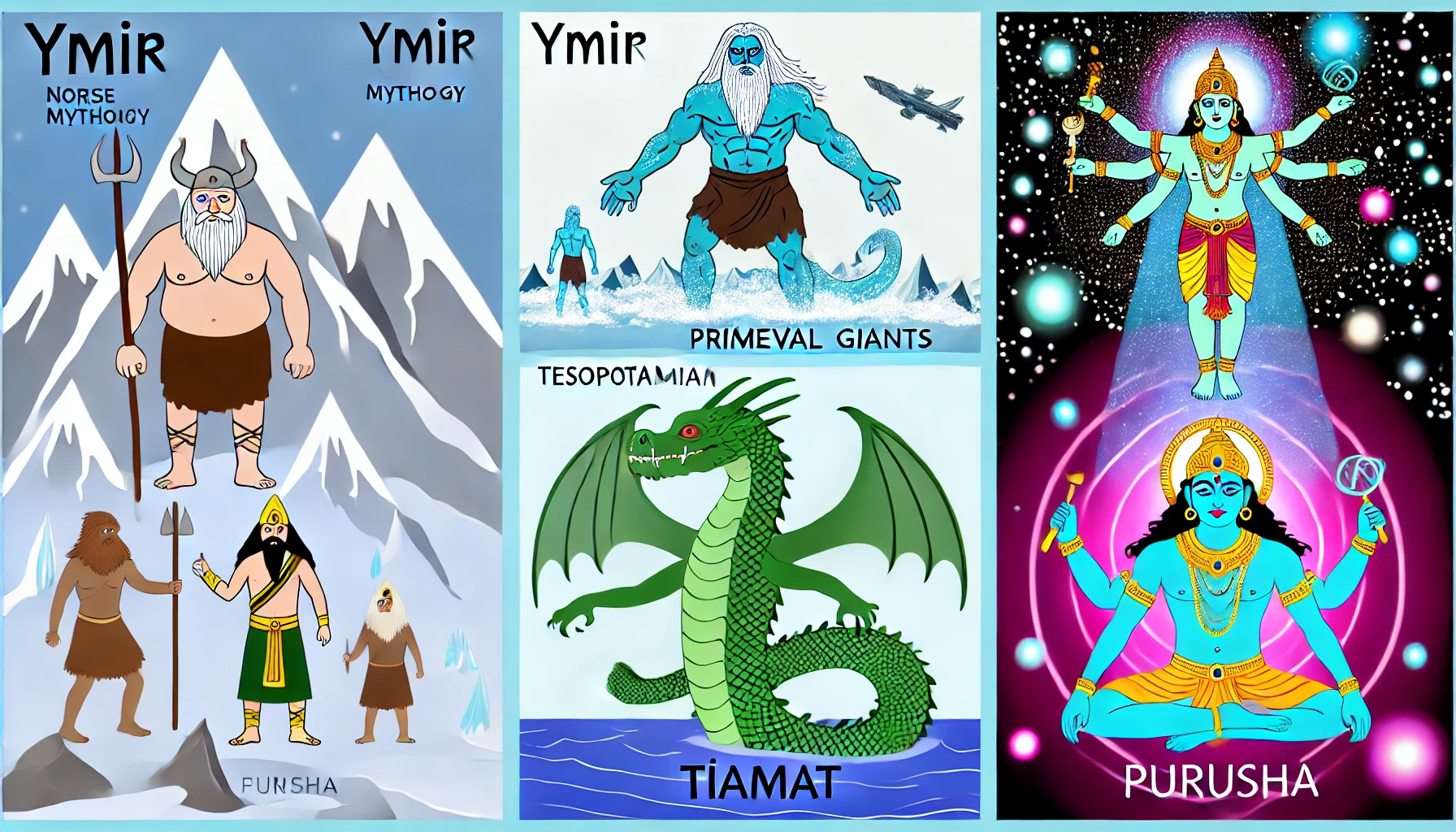
Ymir and Audhumla: The First Beings in Norse Myth
Ymir’s presence in the mythic void was accompanied by Audhumla, the great cow whose milk sustained him. Yet, Audhumla did more than nourish Ymir; as she licked the salty ice of Ginnungagap, she revealed Búri, the ancestor of the Norse gods. From Búri came Bor, who would father Odin, Vili, and Vé, the three gods destined to bring about Ymir’s downfall. This connection between Ymir and the gods through Audhumla’s actions underscores the intricate balance in Norse mythology, where life and death, creation and destruction, are tightly woven together.
A Divine Conflict: Ymir Versus the Gods
As Odin and his brothers grew in power, they recognised Ymir’s existence as both a source of creation and a threat to the emerging cosmic order. Ymir, embodying the chaotic forces of Ginnungagap, could not coexist peacefully within the structured realms the gods intended to build. This tension culminated in a violent clash, where Odin, Vili, and Vé struck down Ymir in an act that would shape the world forever.
The slaying of Ymir was not merely an act of violence; it was a cosmic transformation. His enormous body held within it the raw elements needed to form the world, and the gods used his remains to craft the physical realms. From this primordial sacrifice, Ymir’s blood became the seas, his flesh the earth, his bones the mountains, and his teeth the rocks. His skull was placed as a vault for the sky, and his brain scattered to create clouds. In one sweeping act, the gods turned the primeval giant of Norse mythology into the foundation of Midgard, creating a habitable world from his vast, lifeless form.
Ymir’s Body as the Foundation of Midgard
The story of Ymir’s transformation into the physical world highlights the Norse belief in life arising from sacrifice and the natural cycle of destruction leading to creation. Each element of Ymir’s body held significance in Norse cosmology. His eyebrows, for instance, formed a protective barrier around Midgard, keeping chaotic forces at bay and ensuring the safety of human realms. Ymir’s very essence was thus woven into the fabric of existence, his death a necessary step in bringing life, order, and structure to the cosmos.
In Norse mythology, the world was not formed from nothingness but from the corporeal remains of a primordial being. This detail captures the unique view of Norse cosmology: life is created from life, from the sacrifice of something powerful and ancient. Ymir’s story is a testament to the Norse worldview, where existence is deeply connected to transformation, and every creation bears the memory of what came before. Through Ymir, the primeval giant, the Norse cosmos was born from a fusion of chaos and order, life and death, in a story that bridges the vast expanse of Ginnungagap with the rich, vibrant world of gods and men.
Symbolism and Legacy of Ymir, the Primeval Giant of Norse Mythology
Ymir, the primeval giant of Norse mythology, embodies a unique symbolism in Norse cosmology, representing the duality of creation and destruction, chaos and order. His life and death form the foundation of the cosmos, and his story holds powerful symbolic meaning, reflecting the Norse understanding of life as a cycle that rises from conflict and transformation. In Norse lore, Ymir’s narrative offers insight into their worldview, where nature and existence are born not from peaceful origins but from primordial strife, where each phase of life is intrinsically linked to sacrifice.
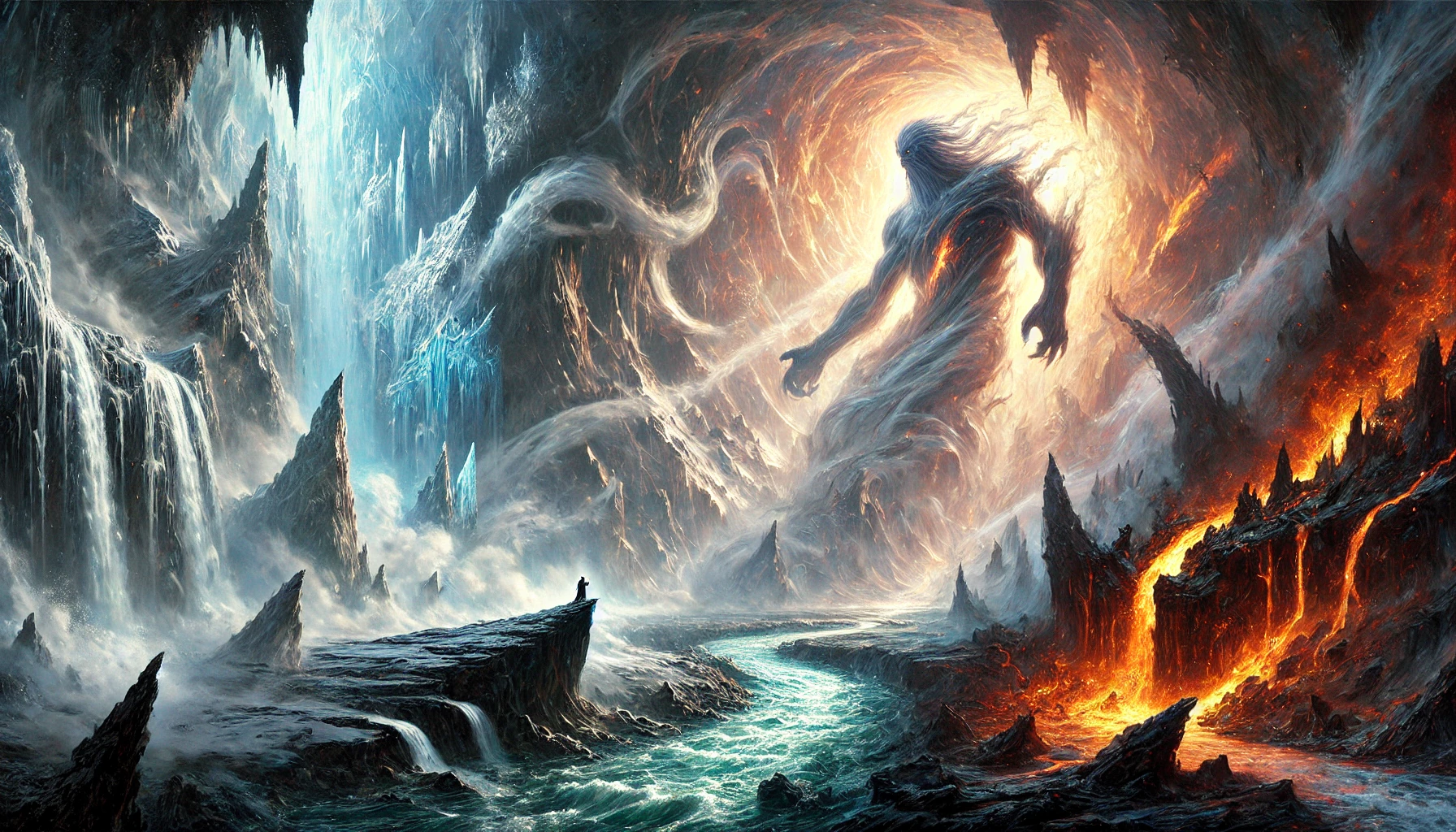
Cosmic Sacrifice and Creation from Destruction
One of the most profound symbols in Ymir’s story is that of cosmic sacrifice. By using Ymir’s body to shape the physical world, the Norse gods underscore a theme that echoes through many mythologies: the idea that creation often requires a significant, sometimes violent, transformation. Ymir’s death at the hands of Odin and his brothers serves as a necessary act, allowing life to emerge from his body. In this narrative, Ymir represents both a source of life and a gateway through which life’s potential can only be realised by surrendering form. His death is not an end but a transition, a cosmic offering that transforms him into earth, sky, sea, and everything within them.
This motif of creation from destruction resonates with similar myths worldwide, such as Tiamat in Mesopotamian mythology, who is also slain to create the world. The Norse adaptation of this archetype suggests a deep reverence for the forces of nature, portraying existence as a balance between birth and decay. Ymir’s legacy reflects this eternal balance, where even the mightiest of beings must submit to the greater forces of creation.
Ymir’s Influence on Norse Cosmology and Cultural Symbols
The story of Ymir as the primeval giant extends beyond the mythic account of his creation and death; it permeates Norse cultural symbols and ideas about the structure of the universe. Ymir’s body, repurposed into elements of the world, serves as a reminder that the earth itself was once living, making the natural landscape sacred and resonant with ancestral life. His transformation into Midgard and the surrounding realms mirrors Norse beliefs about the earth’s spiritual essence, grounding their cosmology in the idea that nature is not merely a backdrop but a vital, living force.
Ymir’s symbolism in Norse cosmology also highlights the idea of protection and separation. His eyebrows, for example, form a protective barrier around Midgard, shielding humanity from the chaotic forces beyond. This physical boundary represents the Norse understanding of order and chaos, with Ymir’s legacy acting as both a shield and a reminder of the wildness that lies beyond human reach. Through these symbols, Ymir’s story lives on as part of Norse cultural identity, a tale that both anchors and protects, reflecting their reverence for the delicate balance between safety and the unknown.
Parallels in World Mythology: Ymir and the Archetype of the Primeval Giant
Ymir’s tale resonates with myths from other cultures, where the archetype of the primeval giant or ancestor figure often signifies the untamed beginning of existence. In Hindu mythology, for example, the giant Purusha is sacrificed to create the world, his body transforming into various elements of the cosmos, much like Ymir’s. Such parallels highlight the shared human impulse to understand life through transformation and sacrifice, presenting giants like Ymir as embodiments of primordial chaos shaped into order.
In Norse mythology, Ymir’s role as the primeval giant captures the very spirit of Ginnungagap—the chasm that held both life and nothingness, potential and void. His existence and legacy remind us that the cosmos was forged not from peaceful origins but from the tumultuous clash of forces, a narrative that resonates with human curiosity about the nature of existence. The story of Ymir is not just about a giant’s life and death; it’s a timeless representation of how the Norse viewed the world, with chaos and creation forever intertwined in the fabric of reality.
The Norse cosmos, shaped from Ymir’s body, offers a rich narrative aligned with other cosmological myths around the world. For a deeper dive into the Norse cosmological framework and its unique features, read more about Norse cosmology.
The Primeval Giant Across Myths: Comparing Ymir to Other Ancient Giants
The Norse myth of Ymir, the primeval giant, stands as a rich example of how cultures around the world have woven tales of ancient giants to explain the origins of life and the cosmos. Giants in myth are often depicted as immense, raw forces of nature—beings who exist before the structured realms of gods and humans. Across various mythologies, these giants embody primal chaos, their existence essential to the world’s formation. In comparing Ymir to other giants in world mythology, we uncover fascinating parallels that highlight humanity’s shared fascination with creation through transformation and sacrifice.
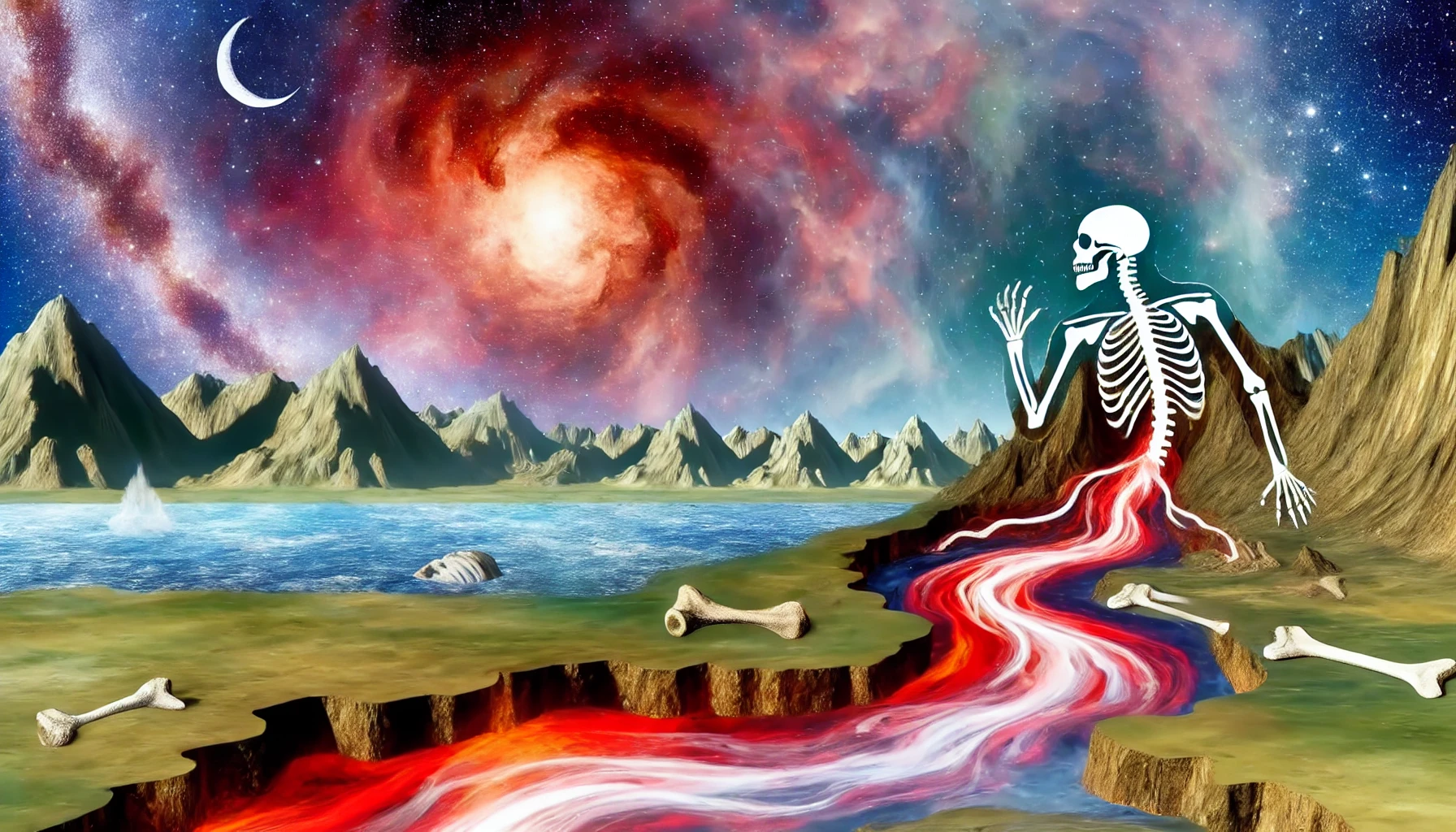
Ymir and Tiamat: Creation from Chaos in Mesopotamian Mythology
In Mesopotamian mythology, Tiamat, a primordial goddess, serves a role similar to Ymir’s as a being whose death brings about the creation of the world. Tiamat, often represented as a dragon or serpent of the sea, symbolises chaos and the untamed forces of the cosmos. When she is slain by the storm god Marduk, her vast body becomes the heavens and the earth, marking a transition from chaos to order. Just as Ymir’s body was used by the Norse gods to form the physical realms, Tiamat’s sacrifice transforms her chaotic essence into the structure of the world.
The similarities between Ymir and Tiamat reveal a shared mythological theme: the universe as a product of conflict between primordial chaos and emerging order. In both tales, giants or god-like beings are the first to exist, embodying the raw, untamed power of nature. Their deaths at the hands of younger, order-seeking deities underscore the cyclical nature of creation in myth—a process where new life rises from the remnants of an ancient one.
Purusha and the Sacrificial Giant in Hindu Mythology
Another powerful parallel to Ymir is found in the Vedic myth of Purusha, the cosmic giant in Hindu mythology. Purusha’s sacrifice is one of the earliest examples of creation through the dismemberment of a primordial being. According to the Rigveda, the gods offer Purusha in a cosmic sacrifice, using his body to create various elements of the world. His mouth becomes the Brahmins (priests), his arms the Kshatriyas (warriors), his thighs the Vaishyas (merchants), and his feet the Shudras (servants), structuring society itself from his form.
Like Ymir, Purusha symbolises the interconnectedness of life and death, as well as the sacredness of sacrifice in bringing forth creation. The dismemberment of both giants into distinct parts symbolises the segmentation of the natural and social worlds from a primordial whole. Ymir and Purusha’s stories illustrate how diverse cultures conceptualised the origins of life as arising from the sacrifice of an ancient giant, linking human society and the natural world to the divine.
Pangu: The Chinese Giant Who Formed the Earth
In Chinese mythology, Pangu plays a role similar to that of Ymir, acting as the primeval giant who shaped the earth. According to legend, Pangu emerged from a cosmic egg and began to carve out the heavens and earth. When Pangu eventually dies, his body transforms into various parts of the natural world: his breath becomes the wind, his eyes the sun and moon, and his body the mountains and rivers. This concept of a primeval giant transforming into the elements of the world echoes the Norse tale of Ymir, whose blood, bones, and flesh formed the seas, mountains, and earth.
Pangu, like Ymir, represents an ancient, sacrificial force, linking the elements of nature directly to the body of a being who predates the world itself. The parallels between Ymir and Pangu underscore the universal theme of life emerging from the remnants of a primordial ancestor, suggesting that the transformation of a single, powerful entity into the world is a mythological archetype that transcends cultural boundaries.
The Nature of Giants: Universal Symbols of Creation and Destruction
Across these myths, giants like Ymir, Tiamat, Purusha, and Pangu symbolise the primordial forces that must be tamed or transformed to create an ordered world. Their existence reflects the early, chaotic state of the cosmos—a time before gods, humans, or structured realms. Through the dismemberment or death of these giants, the natural world and, often, human society are brought into being, linking life with a sacrifice as old as time.
The archetype of the primeval giant offers a window into humanity’s quest to understand existence through narratives of cosmic beginnings. Ymir’s legacy, along with those of other ancient giants, reminds us that creation myths are more than simple stories; they are profound reflections of how we interpret the mysteries of life, nature, and the forces that shape the world. Through these shared symbols of giants, we find a timeless, global narrative—one that connects disparate cultures in their desire to understand the origins of life through the ancient beings who came before us.
The archetype of the primeval giant like Ymir has parallels across cultures, as seen in other ancient myths, including those explored in Giants in the Dead Sea Scrolls: Unveiling the Lost Legends of Ancient Behemoths.
Exploring the Legacy of Ymir Today
The myth of Ymir, the primeval giant of Norse mythology, has endured far beyond the ancient Norse world, weaving its way into contemporary culture, literature, and the arts. Ymir’s legacy is not only a reflection of the Norse cosmos but also a source of creative inspiration and a bridge between past beliefs and modern interpretations. The symbolic richness of Ymir’s story—a tale of creation born from sacrifice, of life arising from chaos—continues to resonate, capturing imaginations and shaping perspectives on existence, nature, and the origins of life.
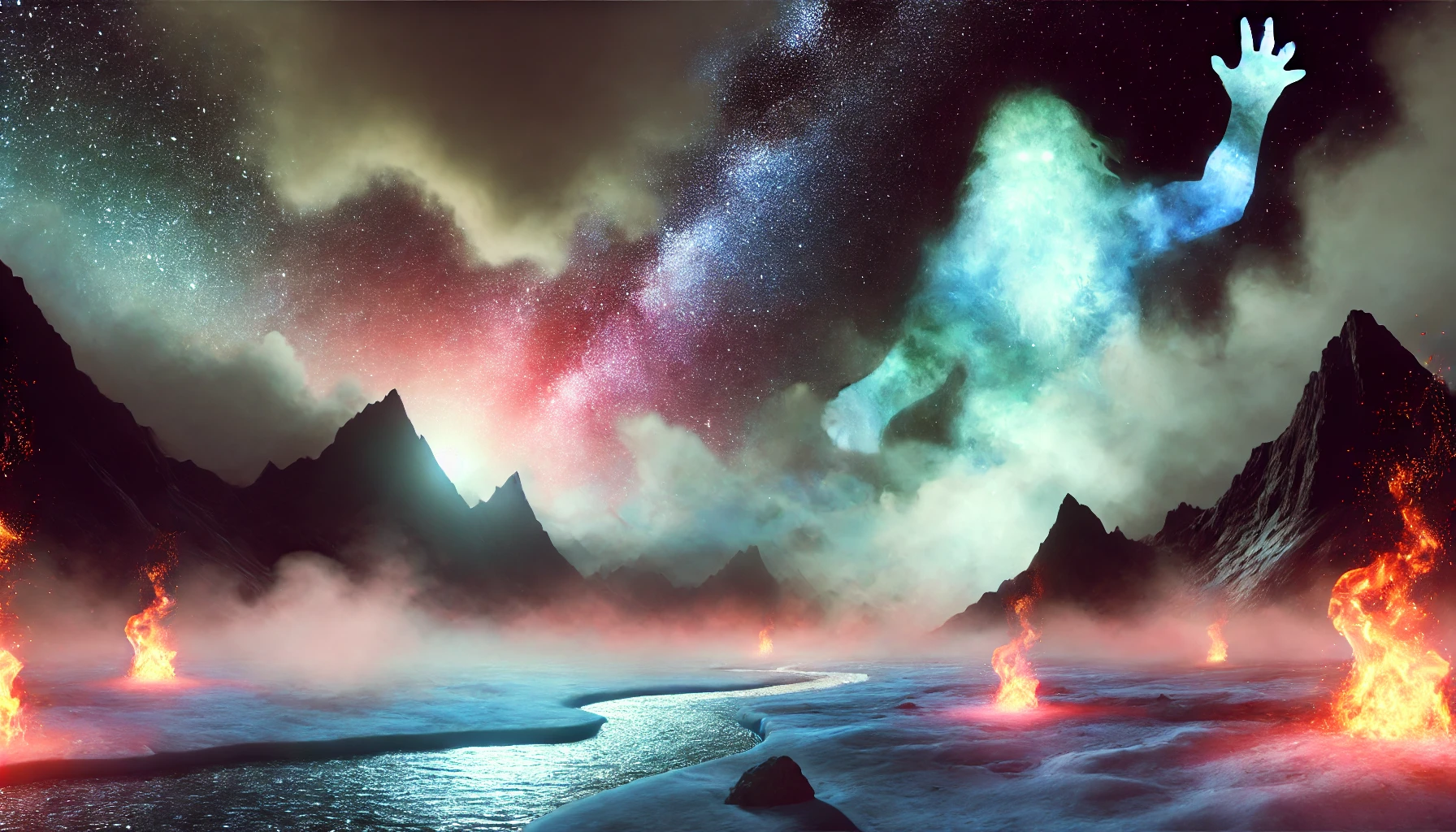
Ymir in Modern Culture and Media
Today, Ymir’s myth can be found in literature, cinema, and popular media, where themes of sacrifice, transformation, and the primordial nature of giants continue to captivate audiences. In the realm of fantasy literature, Ymir’s story has influenced depictions of giants and ancient beings, often portrayed as creatures of immense power whose lives and deaths hold cosmic significance. The themes central to Ymir’s tale—creation from destruction and the transformation of the body into natural elements—frequently appear in modern stories about world-building and origin myths.
In films and television series inspired by Norse mythology, Ymir occasionally appears as a reference point or symbolic figure, embodying the idea of an ancient, chaotic force tamed by gods or heroes. These portrayals highlight the universal appeal of Ymir as a primeval entity, a reminder of the raw power that once shaped the world. In video games and graphic novels with Norse-inspired worlds, Ymir’s influence is woven into landscapes, settings, and backstories, often connecting the in-game environment directly to his mythic legacy.
Ymir’s Influence on Contemporary Environmental Themes
Beyond popular culture, Ymir’s story has also found relevance in environmental discussions and the modern perspective on humanity’s connection to nature. The myth of Ymir, with his body forming the land, sea, and sky, can be seen as an early reminder of the interdependence between humans and the earth. Ymir’s transformation into the natural world underscores the Norse understanding of nature as an entity woven from the remains of a once-living being, implying that the earth is as sacred as it is ancient. This symbolism finds resonance today in environmental movements that seek to honour and preserve the natural world as something more than a resource, but as a living, breathing ecosystem.
As climate discussions increasingly recognise the importance of respecting the earth, Ymir’s legacy serves as a mythological reminder of nature’s primal origins. His story embodies the idea that our environment is not merely a background to human life but a vital part of our own cosmic heritage, shaped by ancient forces and forever linked to our existence.
The Enduring Appeal of Ymir and the Primeval Giant Archetype
The figure of Ymir, the primeval giant, endures not only because of his dramatic role in Norse mythology but also due to the universal archetype he represents. Giants like Ymir embody the chaotic forces that predate structured reality, evoking a fascination with ancient, untamed energies that lie at the heart of many myths. His tale is a window into humanity’s timeless quest to understand creation, death, and the cycle of life—a theme that has fascinated poets, artists, and thinkers for centuries.
As contemporary interest in Norse mythology grows, Ymir’s legacy continues to inspire, bridging ancient beliefs with present-day questions about existence and humanity’s role within the universe. Through his myth, we are invited to look back at the mysterious origins of life, to imagine the primordial void of Ginnungagap, and to recognise that every world, every mountain, sea, and sky, has its roots in the sacrifices of beings like Ymir. His story remains a timeless reflection of the delicate balance between creation and destruction, inviting us to explore the mysteries that lie within our own connection to the cosmos.
In the Wake of Ymir: What We’ve Learned
The myth of Ymir, the primeval giant of Norse mythology, offers profound insights into ancient Norse perspectives on creation, nature, and the cosmos. His story, which moves from his mysterious birth in Ginnungagap to his transformation into the physical world, weaves together themes of chaos, sacrifice, and cosmic balance. From this tale, we gain a deeper understanding of how the Norse envisioned existence as a delicate interplay between destructive forces and creative renewal—a vision that reflects humanity’s innate fascination with life’s beginnings and the mysteries of the universe.
The Power of Creation Through Transformation
Ymir’s transformation into the earth, seas, and sky underscores a key Norse belief: creation requires transformation, and life is born from the essence of what came before. This concept resonates through Ymir’s narrative, with his body becoming the foundational elements of the world. The myth highlights the Norse understanding of the earth as not just a physical place but a living, ancestral entity with a sacred lineage. This perspective invites readers today to view the natural world not as separate from us but as part of a continuum that began with ancient forces and continues through every mountain, river, and forest that surrounds us.
Nature as Sacred and Interconnected
The story of Ymir reminds us that, in Norse cosmology, nature is infused with life and meaning, crafted from the body of the primeval giant. By creating Midgard from Ymir’s flesh and bones, Norse myth reinforces the idea that nature is intimately connected to human life. The Norse viewed the land as more than mere terrain—it was a relic of ancient life, something to be honoured and respected. Ymir’s legacy encourages a sense of kinship with the world around us, urging us to consider our relationship with the earth as both caretakers and inheritors of a cosmic heritage.
The Universal Archetype of the Primeval Giant
Ymir’s tale not only enriches our understanding of Norse mythology but also connects to a broader mythological pattern shared across cultures. The archetype of the primeval giant—a colossal, ancient figure whose sacrifice births the world—appears in many traditions, from Purusha in Hindu mythology to Tiamat in Mesopotamian lore. This universal archetype speaks to humanity’s collective quest to comprehend our origins and make sense of the forces that shape existence. Ymir’s presence in this pantheon of primeval giants highlights a timeless fascination with the mysteries of life, death, and rebirth.
Continuing Exploration of Ymir’s Myth
As we continue to explore Norse mythology, Ymir’s story serves as a vital starting point for understanding the beliefs and values of ancient Scandinavian societies. His myth encapsulates ideas that resonate today: the sacredness of the earth, the necessity of sacrifice, and the power of transformation. Ymir’s legacy, preserved in Norse myth and echoed across cultures, invites us to ponder not only the mysteries of the past but also our own place within the ongoing narrative of the cosmos. Through the lens of Ymir, we are reminded that the quest for understanding our origins is as old as time itself.
Diving Deeper: Your Questions on the Primeval Giant
In the myth of Ymir, the primeval giant of Norse mythology, many complex themes and symbolic elements invite further exploration. Below, we address some frequently asked questions about Ymir and his role in the Norse cosmos, helping to unravel the deeper layers of his myth and its significance in ancient Scandinavian beliefs. This section provides context and clarity on Ymir’s unique position as both the origin and the foundation of life, shedding light on his legacy in mythology.
What does Ymir represent in Norse mythology?
Ymir represents the raw, untamed forces of nature that existed before the ordered world took form. As the primeval giant, he embodies the concept of primordial chaos—an elemental state where fire and ice collide, giving birth to life. His existence symbolises the Norse belief in life’s cyclical nature, where creation, destruction, and renewal are eternally linked. Through Ymir, the Norse saw the cosmos as something emerging from chaos, shaped and structured by divine intervention.
How did Ymir’s death contribute to the creation of the world?
Ymir’s death is a pivotal event in Norse mythology, where his body becomes the material foundation of the cosmos. When Odin, Vili, and Vé slay Ymir, they use his flesh to create the earth, his blood to fill the seas, his bones to form mountains, and his skull as the sky’s vault. His death is both sacrificial and transformative, demonstrating that the Norse cosmos was born from the remains of an ancient, living being. This transformation from chaos to order signifies the Norse worldview: life and existence emerge from the ultimate act of creation through destruction.
Are there other giants like Ymir in different mythologies?
Yes, the concept of the primeval giant appears across various mythologies, where giants or ancient beings are sacrificed to create the world. In Hindu mythology, Purusha is sacrificed to form the world and establish social order. Similarly, in Mesopotamian mythology, Tiamat is slain by Marduk, with her body used to shape heaven and earth. These stories share a common archetype—life emerging from the remains of a powerful primordial being—suggesting a shared cultural fascination with cosmic beginnings and the transformation of chaos into order.
Why is Ymir considered “primeval” in Norse mythology?
Ymir is considered “primeval” because he is the first living entity to emerge from the primordial void, Ginnungagap, predating even the gods. His existence precedes all others, embodying the raw potential of creation in Norse cosmology. Ymir’s status as a primeval giant signifies his foundational role in the universe, bridging the chaotic beginnings of Ginnungagap with the structured realms of gods, humans, and nature. As the original giant, he represents the origin of life itself within the Norse mythic framework.
What is Ginnungagap, and how does it relate to Ymir’s story?
Ginnungagap, the “Yawning Void,” is the primordial space where creation first begins. Situated between the realms of fire (Muspelheim) and ice (Niflheim), it is here that the interaction of these elemental forces produces Ymir. As the birthplace of the primeval giant, Ginnungagap symbolises the boundless potential of the universe, a space where opposites meet and life emerges. Ymir’s emergence from Ginnungagap represents the first stirrings of life from lifelessness, setting in motion the events that would ultimately lead to the creation of the world.
In examining Ymir’s myth, we discover the intricate layers of Norse cosmology and its unique approach to life, death, and the natural world. Through his story, we encounter a narrative that bridges ancient beliefs with timeless questions, inviting us to reflect on the origins of existence and the mysteries that continue to shape human understanding.

